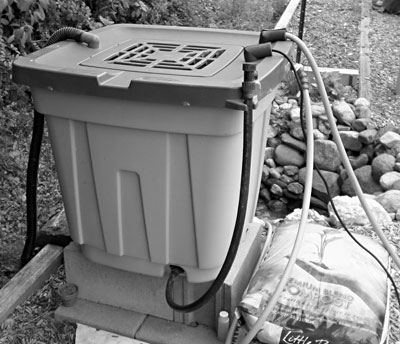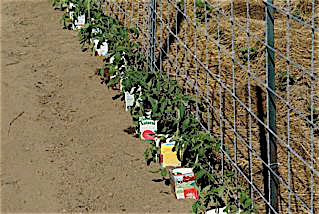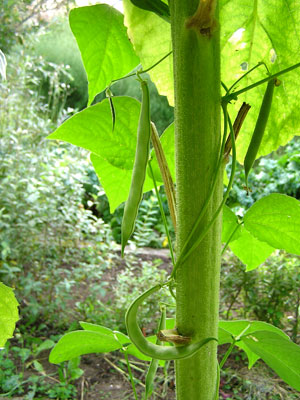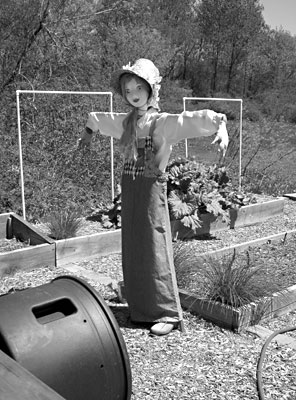 |
| My source of water is city water, which can be expensive if watering a large garden. I have a sump pit in my basement, so I set up a rain barrel and attached a sump hose from the pit outlet pipe to the rain barrel through an opening I cut in the rain barrel cover. I placed a small submersible pump into the barrel, attached a hose with a spray nozzle and used an outside electrical cord to go between the submersible pump cord and my outside receptacle (cutting holes in the rain barrel cover for both the cord and hose). When the barrel is full, I plug the cord into my outside receptacle and water with the sump pit water, which is as clean as any rain water. (I check to ensure that the pit and rain barrel pumps aren’t leaking grease or oil). Once the rain barrel is full, I remove the sump hose from its cover and reattach after I have used all the water. LP |
By Roberta Bailey
Maine is rich in opinionated, innovative gardeners and farmers. Our reasons for doing things a certain way have evolved and grown up around us just as our farms and fields have. Our process gets tweaked and refined each year. Next year we vow never to put the squash next to the onions, to plant the melons farther apart, to feed the garlic twice and to try a different variety of spinach in the high tunnel.
I love to gather with other growers, whether to lend a hand in the field or lift a glass around the table, and share and ponder the successes and failures, the marvels and puzzlements of the year. It is the science of our rural lives. We are writing our own study guides.
Here is a collection of favorite tips from a small and random group. Thanks to those who responded to our solicitation for tips! As you read, jot down a few of your own ideas and send them to me ([email protected]) for a future article.
***
We find that certain crops (particularly crops that like cooler temperatures, such as broccoli) do better when plants are started in large wooden flats rather than plastic plug flats. Plant in neatly aligned, well-spaced rows and remember to block off the plants (cut through the soil mix with a knife) twice before planting. Cut between rows in one direction, wait three days and cut in the other direction and then wait three more days before transplanting. Use a spatula to lift the blocks of plants out of the flat. AT+JZ
Instead of planting greens mixes, plant mesclun (such as arugula, mizuna, mustard, kale and chervil) in individual rows or blocks. These greens tend to have slightly different maturation windows, with slower growing chard, tatsoi and parsley in garden-ready mixes being overshadowed and out-competed by mustard greens, kale and Chinese cabbage. Blocking out greens allows for optimum harvest and makes it easy to graze a planting repeatedly. I also like to hand-pick larger leaves, rather than cutting down the entire row of greens. When mizuna and arugula are blossoming into braising stage, ‘Red Russian’ kale and ‘Tokyo Bekana’ are still salad-worthy. HC
I had given up growing lettuce because the slugs always got it, despite all the anti-slug tricks I tried (even Sluggo). My yard is Slug Central. But I finally found a way to grow lettuce: in hanging baskets! I start seeds in six-packs very early, and when my greenhouse is no longer freezing at night, I transplant the seedlings into wide, shallow, hanging baskets there. When the greenhouse starts getting too hot, I hang the baskets outside from a metal rod between two posts. When it starts getting too hot outside, I hang them in a shadier place, usually from a tree branch. We now get unmolested baby lettuce for our salads! CP
We use a green mesh shade cloth from Lee Valley Tools for lettuce. We support it on bamboo poles, or stakes. We grow looseleaf and butterhead lettuce; the shade cloth delays bolting and keeps the lettuce very tender. AT+JZ
Instead of direct seeding corn, we start ours in a plastic 38-plug flat, with two seeds per plug, thinned to one later if planted closer than 1 foot. They transplant well and result in a consistent stand of corn with good pollination. AT+JZ
Start sweet corn early to beat the crows and get a jump on the season. We use 1.5-inch soil blocks, with two seeds per plug, and transplant at the three-leaf stage at 12-inch centers. PG+PS
Building slightly concave raised beds and making a shallow trough for seeds and seedlings keeps water in place for the plants/seeds. We also make a “saucer” of soil around each large transplant. C+BE
Don’t pre-soak pea seed before planting. We soaked seed for two rows overnight and didn’t soak seed for another two rows, then planted in same area at the same time. We got consistent germination for the unsoaked seed but inconsistent for the soaked seed. AT+JZ
 |
| We support tomatoes with cattle panel (heavy wire panels, 50 inches by 16 feet, from Agway or Tractor Supply). The holes are big enough so that tomatoes don’t get trapped. We support each panel with three metal “T” posts evenly spaced. Google “In search of the perfect tomato trellis” for details. Cattle panels can also be “bent over” in a half circle to support cucumbers, anchored at the corners with short metal posts. We like this for Japanese cukes, as it helps them grow straight and long. AT+JZ |
To inoculate pea seeds with nitrogen-fixing bacteria, I slightly moisten the seed in a bowl and mix the inoculant into it. The inoculant adheres well. Leftover seed is put back in the packet with no damage to the seed. RB
We don’t plant nightshades until the weather has really warmed (mid- to late June in our area), but we also want to put out strong, healthy plants. We use waxed cardboard milk or juice cartons as our “pot.” Cut off the top and bottom, place them in a wooden tray and fill with potting soil. You’ll get 8 inches of roots. When planting, slip the carton up off the roots so that the bottom of the carton is flush with the top of the soil level. You can also bend down a tab on the carton and use it to label the plant; it stays with the plant throughout the season. The carton also defeats cutworms. AT+JZ (Author’s note: I do this for plants in the high tunnel; the raised cartons also act as great watering tubes.)
We used to plant thousands of shallot bulbs, which grew quickly but had soft, floppy tops that made hoeing difficult. Mulching with oat straw in the spring tended to produce a volunteer cover crop of oat plants that was worse than the weeds. Plastic mulch speeded crop maturity but required a tool to penetrate at each plant location. We created a paper template to wrap around the rolls of black plastic and drilled 3/8-inch holes into the plastic about 8 inches apart each way. As these would become closer together as the plastic neared the center of the spool, we drilled through only the outer half of the roll. The unrolled plastic had a uniform grid of holes spaced where we wanted to plant. In soft ground we could push individual cloves through the holes with our fingers. BW
When we use plastic mulch for peppers, tomatoes or squash, I lay a long tape measure the length of the bed and use a propane torch to create holes at desired locations for the transplants. It takes only a moment to burn each hole, the size can be controlled by how long the flame is applied, and no flap remains. BW
A cover photo on the Johnny’s catalog showed lettuce growing on black plastic, so I tried setting lettuce transplants on plastic to form a barrier to bottom rot that plagued our crops in hot, humid, late summer weather. A few transplants that didn’t get enough water wilted and burned up the first day where they touched the black plastic, but nearly all the remainder matured without any bottom rot. Now white on black mulch is available for cool weather crops; this should be much better for lettuce. BW
One year crows watched us prepare a field for winter squash with black mulch with holes burned in it. We put several seeds in each hole. For more than a week I watched daily from afar for signs of germination. Finally, I walked the rows and found muddy crow footprints along all the plastic. The crows had eaten nearly all the seeds. By chance, we were spared a repeat of this in the next field we planted. We were unable to finish seeding at the end of the day, so we burned the holes and went home. When we returned several days later, the crows had left their telltale footprints along the plastic but must have been perplexed that none of these holes contained seeds as before. I hope those crows don’t have articles in their version of the MOFGA paper (The Treetop Tattler) sharing their garden lore with new crow homesteaders as we do! BW
 |
| Half-inch metal conduit (sold at home supply stores for about $2.50 per 10-foot length) makes great stakes for tomatoes and pole beans. It’s easy to push into the soil and to pull out and store in fall.‘Mammoth Grey’sunflowers also make great pole bean stakes and support pollinators at the same time – a tip I learned from Will Bonsall. I remove the lower leaves of the sunflowers as the beans grow up the plants. JE |
All year I dump my coffee grounds into a big, square, food-grade plastic container in the kitchen. Come spring, I erect an inch-high protective ring around transplanted seedlings and newly emerged beans, lettuce and the like. Slugs and snails, which I seem to house in abundance, will not cross the gritty ridges, and rain does not wash the grounds away. They are cheaper and more effective than diatomaceous earth. NC
We use rolls of copper mesh from Lee Valley Tools to protect carrots and other vulnerable crops from slugs. Slugs recoil from the touch of copper, so a 3-inch high copper mesh fence stops them cold. AT+JZ
I mix wheat bran with Bacillus thuringiensis (Bt) and sprinkle it on the ground around vulnerable plants to kill cutworms. TV
We cover crop in the fall, so often have abundant cutworms in spring. We use nematodes periodically for control, but we also grow peas where we grew cucurbits the year before. In that case we leave the IRT mulch on the ground throughout fall and winter so that in early spring it warms the soil. We remove it and then plant our peas. No fall green crops means no cutworms in spring. AT+JZ
We cover our newly sown carrot seeds with potting soil to mark the row well and because the tiny seedlings easily push through the light mixture. AT+JZ
We try to standardize row widths to match our tillage equipment and scuffle hoes. We hoe weeds to a narrow band when they are very little and then weed the last inch or two in the row by hand. We try to seed to stand wherever possible, and record the seeder setting in a book, on the seed packet and on the stake. If no record of planter setting is available, we trial new seeds on a tarp in the barn to match the planter setting to the desired seeds per foot. We record this information on the seed packet. As seed lots have different seed counts even for the same variety, trialing this in the barn can be helpful. When we finally dash out to plant (just before dark or as thunderclouds gather), we do not have to anguish over which planter setting to use. Also, we can plant seeds that use one planter setting first, then change the setting for the next group and so on to cut down on time in the field. This is even more useful when swatting blackflies with one hand and planting with the other. BW
Brush one side of a light-colored piece of letter-size paper with organic butter, olive oil or honey – anything edible and sticky. In the garden, brush the sticky side of the paper across the tops of crops where flea beetles are active. They jump when disturbed and stick to the paper. Repeat as necessary, probably on a few successive days, to get rid of most flea beetles. Then repeat whenever you notice their presence. NO (Author’s note: I have used Tangletrap on yellow card stock.)
 |
| I deter deer and other critters by putting up a female scarecrow with blowing skirt and flowing pieces of tape-type material, and I place human urine and Irish Spring (yucky smell) about. So far, so good. LP |
Insect netting is a great protective covering against flea beetles and cabbage worms. I can see how the plants are doing, there is less wind resistance than with row covers, and the plants can support the weight without hoops. The Brassicas are beautiful. BB
Planting fall potatoes (2nd succession) around July 4 drastically reduces Colorado potato beetle pressure. PG+PS
I interplant cabbage family plants with tomatoes to enable easier access for harvesting tomatoes; it is easier to step around cabbages than around tightly spaced tomato cages. Also, tomato plants give off an odor that repels cabbage white butterflies. PG (Ed. note: We do not know of research to verify the effectiveness of the tomato odor, but gardeners could test this themselves.)
Squash and pumpkins grow wonderfully in hugelkultur mounds, and hugelkultur is a great way to recycle rotting logs. JE
Harvest a winter rye cover crop as straw in mid-June before seed is viable. Plant successions! PS+PG
I use immature weeds as a cover crop. DR
Cover eggplants with a segment of light-colored panty hose to keep bugs off and let in light. The panty hose stretches as the eggplant grows. Perfect exhibition specimen! AT+JZ
Teaching interns how to water deeply is important, as is prepping the ground around where a plant tree, shrub or large garden transplant will be placed. A fairly deep (deeper than the roots), soft, wide hole can’t be overstressed. We also clip back roots a bit if they are too long. C+BE
Grow a second crop, such as lettuce, at the base (and south side) of your asparagus row in July. Tending the second crop will force you to weed the asparagus rather than ignore it during a busy gardening season. JE
The post harvest garlic patch is a great place for fall greens and daikon or fall-planted strawberries. RB
Wrap young trees in aluminum foil in winter to prevent rodent damage. EC
To root cuttings of fruit trees and others, take cuttings with several buds on each cutting in the spring when they are just about to break dormancy or just budded. I place the cuttings upright into black or dark-colored (for warmth) tubs of well-rotted manure and/or compost, with all but a couple of buds below the medium. Often I add liquid fish/seaweed to the soak water and soak the cuttings in willow-infused water for an hour or two before “planting.” As long as I keep cuttings moist and weed-free, most root. The easiest are grapes, kiwis, currants, gooseberries and mulberries. Trees such as apples are more challenging, with only about 10 percent rooting. Some years are more successful than others; I’m not sure why. EC (Ed. Note: Planting gooseberries is restricted in much of Maine. See https://www.maine.gov/dacf/mfs/forest_health/documents/wpbr_quarantine_2010.pdf.)
I roll up my Trellis-Plus mesh on cedar shingles or 1-inch boards, then mark on the board the length and condition. I also write with a marker the approximate length and condition on my rolled up Agribon or insect mesh row cover. RB
Heavy plastic gallon vinegar jugs make great berry picking buckets. Cut a semi-circular hole in the top third of the jug, below the lid and opposite the handle. Cut the bottom end of the handle so that it can slip into a waistband or belt to leave both hands free. RB
Wander without purpose amid your garden or field. Stop and watch. It is the most important time spent. You will learn so much. RB
Place a table and chairs in your garden or high tunnel to enjoy your beauty around you. LP
And lastly from my friend “Relentless”: “Don’t listen to other humans! Immerse yourself in the living ambience. Breathe, smell everything, taste, touch, see, hear and feel.”
Contributors
| AT+JZ | Adam Tomash and June Zellers |
| BB | Betsy Bott |
| BW | Ben Wilcox |
| C+BE | Carol and Bruce Emerson |
| CP | Claire Prontnicki |
| D+BB | Deb and Bruce Brown |
| DR | David Rogers |
| EC | Emily Cates |
| HC |
Holli Cederholm |
| JE | Jean English |
| LP |
Leslie Poole |
| NC | Nan Cobbey |
| NO | Nancy Oden |
| PG | Peter Garrett |
| PG+PS | Prentiss Grassi and Polly Shyka |
| RB | Roberta Bailey |
| TV | Tom Vigue |
Roberta will be compiling tips about growing plants in hoophouses for an article next year. You can send ideas to her at [email protected].
